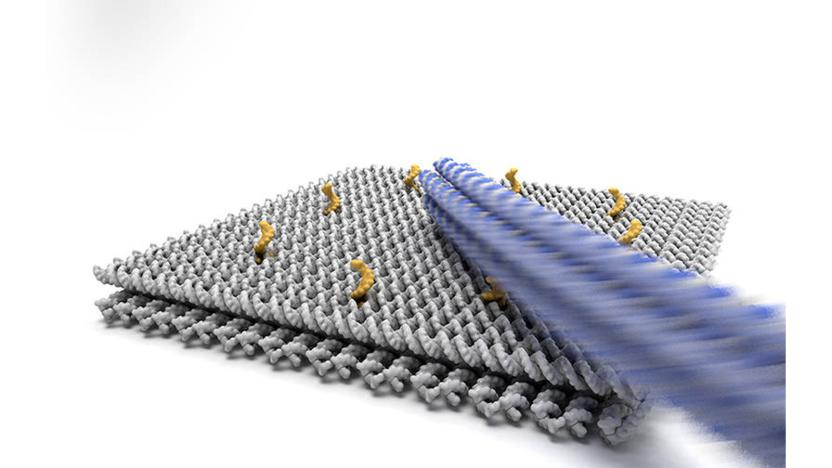nanobot
Latest

Speedy DNA nanorobot could lead to molecular factories
DNA-based robots promise all kinds of microscopic machinery, but there's a major obstacle: they're slow. Existing designs that use biochemical processes for movement can take hours to shuffle molecules around, which makes them utterly impractical for anything time sensitive. That might not a hurdle for much longer. Scientists have developed a DNA nanorobot (specifically, an arm) that uses electric fields to move a whopping 100,000 times faster than previous examples, even though it's based on straightforward concepts.

Sperm microscope may help nanobots navigate human bodies
Scientists have developed a microscope that allows them to track sperm movements in 3D, which could benefit the understanding of both fertility treatment and micro-robotics. The device is made up of inexpensive components including LEDs and an image sensor -- like the one found in a mobile phone -- and uses holography and image reconstruction algorithms to precisely track the motion of sperm heads and tails.

Nanobots get tiny propellers for targeted drug delivery
Nanobots need the proper propulsion system if they're going to be used to deliver drugs to targeted areas. Take for example this teeny-tiny corkscrew-shaped propeller made out of silica and nickel that's developed by a group of German and Israeli scientists. The team says it's around 100 times smaller than the diameter of a red blood cell at 70 nanometers in width and 400 nanometers in length, so it can swim through blood and other fluids without getting caught in protein chains and the like. In order to make a nanopropeller this small, its creators had to forego giving it a motor of its own -- it needs to be controlled externally by a weak rotating magnetic field.

EVE Evolved: New Ancillary Armor Repairers aren't up to the task
EVE Online's Retribution 1.1 patch went live this week, overhauling armour tanking and rebalancing some ships that traditionally fit armour tanks. Last week I looked at why people usually choose passive buffer tanks for PvP over active tanks and how the Ancillary Shield Boosters changed all that by giving shield users a huge free burst tank that can often outperform a front-loaded buffer tank. The new Ancillary Armor Repairers look similarly amazing on paper with their ability to consume nanite repair paste to triple repair output, but how do they stack up against their shield-based counterparts? Now that the patch is out and I've finally got my hands on the Ancillary Armor Repairers, I'm not sure they're any good. They're limited to one per ship even though most active armour tanking ships use dual or triple repairer setups, and they can run for only eight repair cycles before running out of paste. They're also only 68.75% more effective than tech 2 repairers and still require the same amount of capacitor. Ancillary Shield Boosters may provide a slightly smaller 63.33% repair boost over tech 2 boosters, but they can cycle at double the rate of Ancillary Armor Repairers and don't require any capacitor. In this week's EVE Evolved, I look at what makes Ancillary Shield Boosters a strong contender in PvP and show that the new Ancillary Armor Repairers just aren't up to the task.

Georgia Tech models swimming, cargo-carrying nanobots
The nanobot war is escalating. Not content to let Penn State's nanospiders win the day, Georgia Tech has answered back with a noticeably less creepy blood-swimming robot model of its own, whose look is more that of a fish than any arachnid this time around. It still uses material changes to exert movement -- here exposing hydrogels to electricity, heat, light or magnetism -- but Georgia Tech's method steers the 10-micron trooper to its destination through far more innocuous-sounding flaps. Researchers' goals are still as benign as ever, with the goal either to deliver drugs or to build minuscule structures piece-by-piece. The catch is that rather important mention of a "model" from earlier: Georgia Tech only has a scientifically viable design to work from and needs someone to build it. Should someone step up, there's a world of potential from schools of tiny swimmers targeting exactly what ails us.

CIA dragonfly drone almost beat modern UAVs by 40 years, was swatted (video)
US intelligence agencies were just as obsessed with drone spying 40 years ago as they are nowadays -- only then, it was pipe-smoking entomologists and watchmakers who were in charge of building prototypes. Back in the '70s, the CIA needed some kind of miniature flyer to deliver an audio bug, and after considering (and rejecting) a faux bumblebee, decided that a robotic dragonfly would be the best option. The wee UAV used a "miniature fluidic oscillator" as a motor and was propelled by a small amount of gas. It was somehow guided by a laser beam, which served double-duty as the "datalink for the audio sensor payload," according to the CIA Museum. Unfortunately, the insect-based mech proved too difficult to control, especially with any degree of wind, and was eventually scuppered -- all that's left of the now-declassified project is in the video after the break.

Inhabitat's Week In Green: 3D printed veins, solar cell towers, and the Ingocar
At Inhabitat we've seen 3D printers that create entire buildings out of stone and complete meals out of simple ingredients, but this week we watched in awe as scientists used a 3D printer to create the world's first "printed" human vein. And if advances in biotech get your blood flowing, you'll be excited to hear that this week a team of researchers successfully tested a new type of nanobot that travels through the bloodstream to turn off tumor cells. Contact lenses are also getting a much needed upgrade as scientists unveiled a new type capable of fighting glaucoma and other diseases by dispensing a powerful dose of medication. In other news, solar energy is lighting up the world at large as India gears up to power all of its cellphone towers with photovoltaic cells, saving 5 million tons of CO2 and $1.4 billion annually. And speaking of silicon cells, the National Renewable Energy Laboratory recently unveiled its latest creation: a super robot capable of assembling an entire photovoltaic cell in 35 minutes flat. We also looked at a prototype of a prismatic solar balloon that uses a colorful new type of solar cell to soak up the sun's energy from high in the sky. Finally, this week we took an in-depth look at the Ingocar, a hydraulic hybrid drive vehicle so light and efficient that it promises a mileage of 170MPG. This next-gen vehicle uses hydraulic fluid under pressure to accelerate, brake, and eliminate the need for a heavy mechanical drive train, making it 50% lighter than hybrid electric vehicles. And if you've ever experienced the maddening anxiety of circling for a parking spot on crammed city streets, relax - there's an app for that!

Video: Nanosoccer... Oh. My. God.
Sometimes human awe and incredulity can only be invoked with the help of moving images. A truism related to overzealous police and nanobots alike. We've heard about the RoboCup nanosoccer exhibit since it was first on show back in 2007. However, it took this video of a microbot pushing a football on a field smaller than a grain of rice to fully ratchet our jaws to the floor. See what we mean after the break. [via Medgadget]

Researchers create a nanobot-controlling "brain"
Our inevitable incorporation into the gray goo inches ever closer today, as researchers in Japan have developed a chemical brain that can control up to eight nanomachines -- and one day could control thousands. The "brain" is actually a ring of 17 duroquinone molecules, which together measure just two nanometers across. Each molecule can be rotated to four different positions, controlled by the state of the center molecule. In tests, researchers were able to simultaneously control eight nanomachines using the brain, compelling them to dock and undock from the brain. The structure of the brain also means up to 4 billion possible configurations can be switched simply by manipulating one molecule, which may eventually give rise to computing applications -- but those are limited for now, since issuing instructions involves the use of scanning tunnel microscopy. That's a relief -- gray was never really our color anyway.

British prof warns nanotech products are potentially dangerous
While we're eagerly awaiting the day that we can lounge around while armies of nanobots perform their magical alchemy on our garbage and turn it into hot cellphones and delicious Big Macs, one British scientist is warning that the medical implications of nanotechnology have yet to be properly explored, despite numerous products already finding their way to market. Specifically, Edinburgh University Professor and environmental health expert Anthony Seaton argues that almost nothing is known about the potential effect of inhaling nanoparticles, likening the situation to the dangerous particle-emitting asbestos that was installed in buildings prior to 1970 without a second thought. According to some estimates, there are already 200 products containing nanoparticles available to consumers, with hundreds more expected to hit shelves this year -- but Seaton claims that so far, recommended nano testing "simply hasn't happened." Damn, way to ruin our nanobot fantasies, Professor Letdown.




